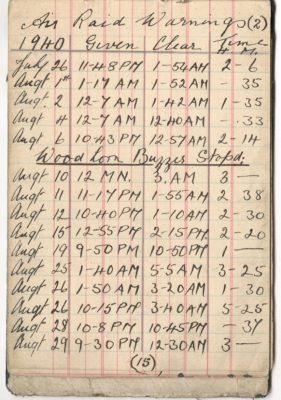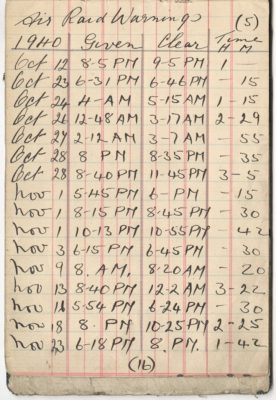Winderman’s Diary, Woodhorn Colliery, 1939-1941
Reference: NRO 05283/C/18/57, NRO 05283/GI/2, NRO 07677/2
Suggested age groups: KS2, KS3, KS4, Lifelong Learners
Subject areas: WW2, Mining
CONTEXT
The winderman was responsible for working the winding engine at the pit. The winding engine was housed in the headgear, or the tower with large wheel on the top, which was characteristic of coalmines. Woodhorn Colliery had two headgears, which can still be seen today.
The winderman decided who could go down into the pit in the cages that were attached to the winding machinery. Even the colliery managers and owners needed his permission. He also had to make sure that as much coal was brought to the surface as possibly during his shift.
This diary notes when air raids sounded at Woodhorn colliery between 1939 and 1941. Like all industrial buildings, Woodhorn colliery was a target for the bombing by the airplanes of the Luftwaffe. They would have been easy to spot from the air and coal was necessary for the war effort. Air raid sirens sounded when planes were spotted overhead to give people time to find shelter. Just after this diary finished, German bombs fell on Woodhorn Colliery. On 20 December 1941, two 500 kg high explosives caused damage to some of the building on the colliery site and left a 20 foot (6 metre) wide crater in the yard.
ACTIVITIES
ACTIVITY 1
Background
The winderman was responsible for working the winding engine at the pit. The winderman decided who could go down into the pit in the cages that were attached to the winding machinery. This diary notes when air raids sounded at Woodhorn colliery between 1939 and 1941.
SEE
See: What does a winderman do?
See: Where did the winderman who wrote this diary work?
See: What does this diary show?
See: How many air raid warnings took place at Woodhorn Colliery between 26th July and 29th August 1940?
See: How many air raid warnings took place at Woodhorn Colliery between 12th October and 23rd November 1940?
See: How many air raid warnings took place at Woodhorn Colliery between 2nd May and 2nd July 1941?
THINK
Think: Why do air raid warnings take place?
Think: What does an air raid warning signify?
Think: Does an air raid warning always mean that there is going to be an attack?
Think: Why do you think the winderman kept a diary of when the air raid warnings took place?
Think: How do you think air raid warnings affected the winderman’s job?
DO
Do: Create a chart showing how often air raid warnings took place each month shown in the winderman’s diary.
Do: Create a chart showing the most frequent times of day that air raid warnings took place. Why do you think the air raid warnings took place most frequently at these times?
Do: Create a chart showing the length of time that air raid warnings lasted, rounded to the nearest quarter of an hour.
Do: Using the data from your charts, write a statement saying what we can learn about the nature of air raid warnings that took place at Woodhorn Colliery in 1940 and 1941.
Do: Using the data from the War and State Society Bombing Britain website, filter the database to only show information from the North.
Do: Create a map to show where was bombed in the north of England during WW2.
Do: Find Woodhorn Colliery on the map. Highlight all of the bombings that took place nearby Woodhorn Colliery.
Do: Compare the information from the winderman’s diary to the data from the War and State Society Bombing Britain website. How many of the air raid warnings shown in the diary turned out to be bombing attacks?
Do: Write a monologue from the perspective of the winderman about air raids in the area.
Resources
ACTIVITY 2
Background
This diary notes when air raids sounded at Woodhorn colliery between 1939 and 1941.
SEE
See: Who wrote this diary?
See: What does this diary show?
See: What is an air raid?
See: What did it mean when an air raid warning sounded?
See: What did people do when air raid warnings sounded?
THINK
Think: How do you think air raid warnings made people feel?
Think: How do you think not knowing when an air raid warning might sound might have affected people?
Think: How do you think air raid warnings impacted people’s well-being?
Think: Do you think that people were able to carry on with their normal day to day life knowing that an air raid warning could sound at any time?
DO
Do: Create an instructional poster showing what to do when an air raid warning sounds.
Do: Set a timer to play at random intervals while you work. When the timer sounds you must turn off the lights, close the curtains and take cover under your desk until the timer sounds again letting you know it is safe to resume working. Teachers could remove a chair to indicate that an air raid attack has taken place and ‘damaged’ that location.
Do: Write down how working while knowing that the timer might sound made you feel. Did it make you more productive or were you distracted waiting for the timer? Did you feel hurried to take cover when the alarm sounded, or were you calm and methodical? How easy was it to resume working after the timer had ended?
Do: Make a word cloud of the verbs and adjectives you used to describe your experience of the timer activity.
Do: Use the words from your word cloud to write a diary entry from the perspective of someone describing their experience of an air raid warning.
Do: Make a list of other alarms that you might encounter in your day-to-day life. Compare how you feel when you hear these alarms to how you might feel hearing an air raid siren. You could use the words from your word cloud to help you.
Resources
OTHER ONLINE RESOURCES
Winderman
Lamasa Tech website, page about creating a display for Woodhorn Museum about the job of winderman: https://www.lamasatech.com/blog/winding-house-no2-opens-its-doors/
Chronicle newspaper website, page about opening of winding house exhibition at Woodhorn Museum: https://www.chroniclelive.co.uk/news/north-east-news/woodhorn-museum-opens-new-visitor-10804418
Air Raids
Imperial War Museum website, page about air raid preparation: https://www.iwm.org.uk/history/how-britain-prepared-for-air-raids-in-the-second-world-war
Imperial War Museum, page about what to do in an air raid: https://www.iwm.org.uk/history/what-to-do-during-an-air-raid
War, State and Society website, page with Bombing Britain database: http://www.warstateandsociety.com/Bombing-Britain
BBC History website, page about winding gear and headgears (unfortunately animation no longer works): http://www.bbc.co.uk/history/british/victorians/launch_ani_winding_gear.shtml#:~:text=Background,to%20reach%20the%20pit%20face.&text=The%20headgears%20are%20the%20iron,power%20of%20gale%2Dforce%20winds.
Mining Heritage East Midlands website, page about the history of winding gear and headgears or headstocks: http://www.miningheritage.co.uk/headstocks/
Woodhorn Colliery
Past Perfect website, page about winderman’s diary (also links to other aspects of Woodhorn’s history): http://www.pastperfect.org.uk/sites/woodhorn/archive/1129.html#




